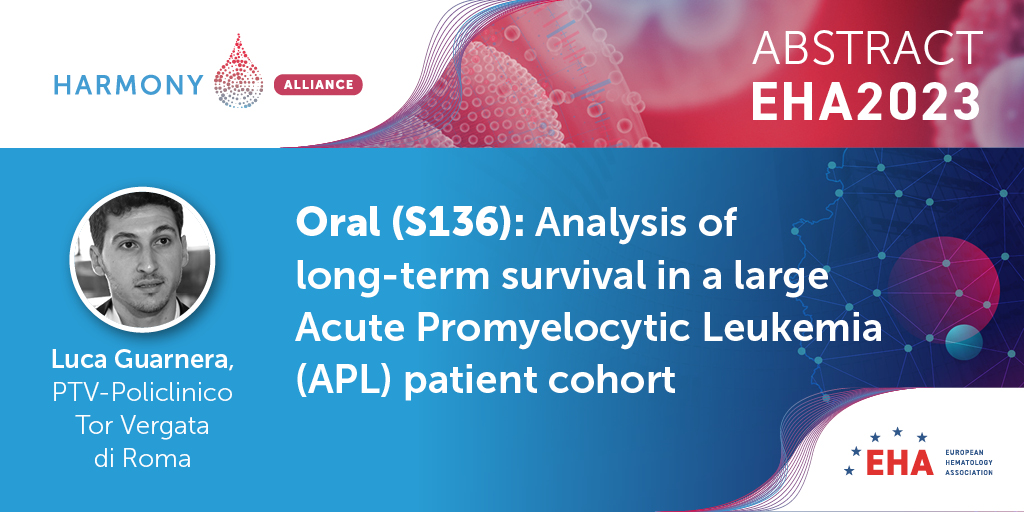Press Release | Frankfurt, 9 June 2023
Once regarded as the most rapidly fatal subtype of acute myeloid leukemia, acute promyelocytic leukemia (APL) is now curable in 75-90% of patients. This is due to the availability of targeted treatments. However, there are multiple unresolved questions regarding the optimal management of this disease. To shed light on these issues, the HARMONY APL research team has analyzed factors associated with long-term survival in a large group of persons diagnosed with APL. Professor Maria Teresa Voso of Tor Vergata University (Rome, Italy) will present the results at the congress of the European Hematology Association.
Read the HARMONY #EHA2023 abstract >

Survival advantage for patients treated with a chemotherapy-free regimen
The researchers studied long-term clinical data from about 900 European patients that were newly diagnosed with APL in the period 2007-2020. Roughly half of these patients had been treated with a chemotherapy-free regimen consisting of a combination of the drugs all-trans retinoic acid and arsenic trioxide (ATRA-ATO). The others had been treated with a combination of ATRA and the chemotherapeutic agent idarubicin (AIDA). The researchers discovered that patients treated with ATRA-ATO had a survival advantage over patients treated with AIDA. After ten years, among patients with standard-risk APL, 90% of the patients treated with ATRA-ATO were still alive, versus 75% of patients treated with AIDA (p<0.001).
Dr Luca Guarnera, also involved in the study, explains: “In multivariate analysis, the treatment confirmed to be independently correlated with a better outcome (overall survival and event-free survival). ATRA-ATO is the preferred treatment in the standard risk group, including low to intermediate risk APL, where it significantly reduces the relapse rate. Differences according to treatment type in high-risk APL are also in favor of the chemo-free subgroup, but the low number of HR-APL patients treated with the chemo-free regimen is a limit to draw a conclusion on this issue. Furthermore, data on ATRA/ATO in HR-APL derive mostly from clinical trials, since ATO is still not approved in many countries in this patient setting. Survival is best in the ATRA-ATO group since this targeted treatment is less toxic at short term and significantly reduces the incidence of events, in particular relapse, significantly improving patients’ quality of life. Furthermore, medium to long-term complications, such as secondary leukemias, have not been reported in patients treated with ATRA-ATO.”
Prognostic value of Sanz-risk score
The researchers conducted several additional analyses with the aim to discover factors associated with long-term survival in the data set. For instance, they investigated the so-called ‘Sanz-risk score’, which is commonly used as a measure of disease severity upon diagnosis in APL patients. This risk score maintained its prognostic relevance in the multivariable analysis, together with age, treatment type, and treatment in the clinical trial scenario.
Survival advantage for younger patients and those enrolled in clinical trials
Younger patients had a survival advantage over older patients (p<0.001 for overall survival and event-free survival at a median follow-up of 5.66 years after diagnosis). The patients had either participated in one of two European clinical trials or they had been treated in a regular clinical setting. Irrespective of treatment, patients that had been enrolled in clinical trials had significantly better chances of survival than patients treated in a regular clinical setting (p=0.025 in the ATRA-ATO group and p<0.001 in the AIDA group).
Professor Voso: “The ATRA-ATO combination confirmed to be a feasible and effective therapy in APL. Moreover, ATRA-ATO combination has less side effects than AIDA. The latter correlates with infectious complications, adverse events, and short and long-term cardiotoxicity, which requires a careful examination of patient fitness. However, high-risk patients treated with chemo-free combination are under-represented in our population. The enrollment of more patients and the inclusion of new partners in the APL-HARMONY project could shed light on this aspect.”
Dr Guarnera adds: “In the near future, we aim to expand our cohort of patients and address pending questions like the use of Gemtuzumab Ozogamicin, ATO dosage, and the role of intrathecal preventive therapy. In addition, secondary versus de novo APL, extramedullary localizations, prevalence of differentiation syndrome will be study topics for the future.”

HARMONY Big Data Platform
The HARMONY Alliance is a community with over 500 professionals, more than 120 partners/member organizations from 19 European countries, and a patient cluster with 9 European patient organizations. When HARMONY started in 2017, the hematology community was embarking on a journey towards embracing data sharing and recognizing the transformative power of big data. HARMONY set a crucial milestone when this endeavor was only starting. By laying the foundation for future collaborations, advancements, and discoveries that would incorporate state-of-the-art technologies in the field of hematology, HARMONY is making its contribution to improve the understanding and treatment of blood disorders.
Now, just six years later, we have transformed both the sharing and use of data. We have developed the Big Data Platform with a data lake that already contains data from 93,000 patients and has identified an additional 60,000 patient records that will be included in the months to come. All data is protected using a unique anonymization and security process. In more than 30 research projects, groundbreaking research is being carried out with the help of advanced customized data analytic services, including AI modelling. The Platform enabled the research team to combine data from APL patient populations enrolled in clinical trials and patients treated in regular clinical settings, to address urgent questions about disease management.
More information
Receive the latest news. Click here to subscribe!